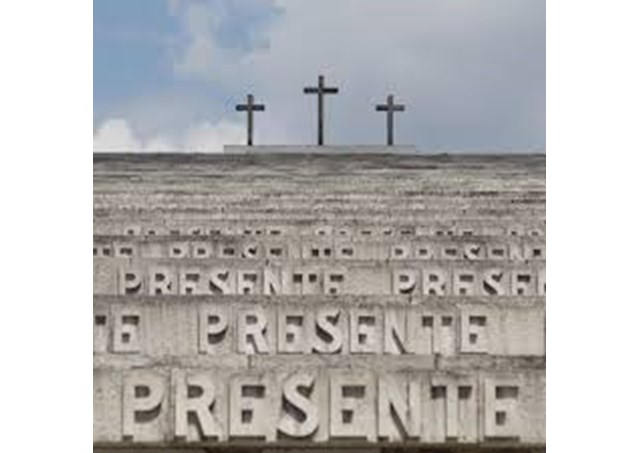
Pope Francis set to visit war memorial of 'Redipuglia'

(Vatican Radio) On the morning of Saturday 13th of September Pope Francis will make a penitential pilgrimage to the north eastern Italian War Memorial of 'Redipuglia', also known at the Memorial of the 100,000. He goes there to pay tribute to all those who fell on the battlefield during the First World War and indeed, as he himself, specified to the fallen of all wars past and present.
A pilgrimage which begins with a visit to the nearby Austro-Hungarian cemetery in Fogliano where Pope Francis will pray and lay a wreath as a tribute to the fallen before celebrating Holy Mass at the War Memorial in the presence of civil and religious authorities. Following Mass he will give all the military chaplains and bishops present a lamp to take back with them to their diocese in remembrance of the fallen.
Listen to Veronica Scarisbrick's report:
This visit marks a century since the beginning of this Great War, triggered on June 28, 1914 by the assassination of the heir to the throne of the Austro- Hungarian Empire, Archduke Franz Ferdinand in Sarajevo. Although the first shots of this conflict were fired a month later on July 28.
The pope of the time was Saint Pius X who was to die on August 20 of this same year, they say of a broken heart because of the senseless slaughter of this war. He was succeeded by Benedict XV, a former Vatican diplomat who found himself leading the Catholic Church at a crucial time in its history.
Pope Francis visits an area of Italy where there was heavy fighting and where the memory of this Great War lies thick on the ground and in people’s hearts and minds.
For the record Italy sided with the Allied Forces in 1915, that’s to say with Britain, France and Russia and for three years fought the Austro-Hungarians on its Alpine borders. The conflict became known as 'La Guerra Bianca' or 'White War'. Austria - Hungary had sided with Germany during this war.
'Redipuglia' is in the Province of Gorizia and lies south of the border with modern day Slovenia. At the time of the Great War it was the eastern tip of the Italian War front and it was here along the ‘Isonzo’ River that some of the bloodiest battles took place. Famously Austrian forces, reinforced by German troops, routed the Italians at the Battle of 'Caporetto' in the autumn of 1917, advancing more than 80 miles. However during the final two weeks of the war, the Italians counter-attacked with the help of British and French troops at the Battle of 'Vittorio Veneto'. A victory of the Allied Forces which would lead to the Armistice of November 1918.
For Pope Francis the Great War in northern Italy is part and parcel of his family history. For as this son of Italian immigrants to Argentina mentioned on June 6 while speaking to one of the Italian Police Forces, the ‘Carabinieri’, he vividly remembers the painful stories relating to World War I recounted to him by his paternal grandfather Giovanni Carlo Bergoglio who fought in this war, a decade before immigrating to the New World.
Pope Francis goes to 'Redipuglia' in the footsteps of Saint John Paul II who paid tribute to the fallen here on May 3, 1992 and called here for peace in the world.
Commissioned during the fascist era, its lay- out is striking with its giant staircase leading uphill towards three great bronze crosses on the horizon of 'Monte Sei Busi'. If you’ve ever visited you cannot have failed to be struck by the deafening silence which blends into the whiteness and immensity of the steps which have the words ‘Presente ‘ engraved on them as a sort of roll- call of the fallen.
Right at the heart of the first row of steps lie the human remains of the only woman in the entire memorial: a nurse by the name of Margherita Kaiser Parodi Orlando whereas at the top of the staircase lie two great tombs covered with bronze plaques where the remains of over 60.000 unknown soldiers lie.
Before reaching the top of the hill there are sculptures representing the Way of the Cross and a Chapel known as ' The Deposition', on which the three bronze Crosses stand in memory of Mount Golgotha.
Interestingly however, while the perception you get of this great white staircase follows an upwards movement, so towards heaven, in the minds of the architect Giovanni Greppi and of the sculptor Giannino Castiglioni the staircase was intended to follow an opposite movement, symbolic of an army descending from heaven.
At the foot of this flight of stairs, there stand some rather majestic looking granite tombs where the remains of the five Generals who led the soldiers into this war are housed, with as centrepiece the remains of the Commander in Chief of the Third Army, the Duke of Aosta, Emmanuele Filiberto.
| All the contents on this site are copyrighted ©. |


